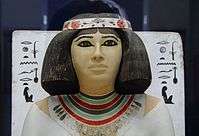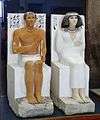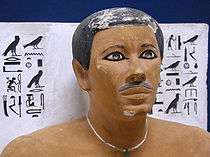Nofret
| Nofret (Nfr-t) | |
|---|---|
 Nofret's statue, Cairo Museum | |
| Resting place | mastaba at Meidum |
| Other names | Nefret, Neferet |
| Title | Princess consort of Egypt |
| Spouse(s) | Prince Rahotep |
| Children |
Prince Djedi Prince Itu Prince Neferkau Princess Mereret Princess Nedjemib Princess Sethtet |
Nofret was a woman who lived in Ancient Egypt during the 4th dynasty of Egypt.
Nefert means "beautiful". Nofret is alternatively known as Nefert or Neferet.
Biography
Nofret's parents are not known. Nofret married Prince Rahotep, a son of Pharaoh Sneferu. She had three daughters and three sons with Rahotep.[1]
Nofret was buried with her husband in mastaba 16 at Meidum.[2] In 1871 by Daninos, beautiful statues of Rahotep and Nofret were found.[3] Nofret is depicted with a black wig and very fair face. Her titles in hieroglyphs on the back of her chair name her as "King's Acquaintance".[4] The statues are now in the Cairo Museum.[5] The mastaba of the couple had two burial chambers and two cult chapels. The Southern cult chapel belonged to Rahotep, the northern one to Nofret. Here she is depicted with Rahotep in front of an offering table. The inscription over the scene provides a second title for her: miteret (translation not known up today).[6]
Children
Children of Nofret and Rahotep were. They all had the same title:
- "King's Acquaintance" Djedi
- "King's Acquaintance" Itu
- "King's Acquaintance" Neferkau
- "King's Acquaintance" Mereret
- "King's Acquaintance" Nedjemib
- "King's Acquaintance" Sethtet[1]
The 2 statues, Nofret and Rahotep
Prince Rahotep's statue has six columns of text, naming his titles and duties, with columns three and six, each ending with his name, Ra-Hotep. Nofret has identical texts, one column both right and left. Her name appears at the bottom, with the determinative for 'women'. Her complete name is "Nsw-r(kh)-t, Nfr-t". The last, nfr-t means "beautiful woman" (the t being the bread bun for feminine); nsw-r(kh)-t, means "King's Acquaintance".
 (Statue 1 + 2)
(Statue 1 + 2)
the pair: Ra-hotep and Nofret
References
| Wikimedia Commons has media related to Nofret. |
- 1 2 Dodson and Hilton, The Complete Royal Families of Ancient Egypt, 2004
- ↑ Dodson and Hilton, The Complete Royal Families of Ancient Egypt, 2004
- ↑ Jacques Kinnaer. "Rahotep and Nofret". Ancient-egypt.org. Archived from the original on 2012-04-14. Retrieved 2012-05-01.
- ↑ "Rahotep and Nofret". Egyptorigins.org. Retrieved 2012-05-01.
- ↑ "Seneferu". Euler.slu.edu. Retrieved 2012-05-01.
- ↑ W. M. Flinders Petrie: Medum, London 1892, plates IX, X and XV (online: )
- ↑ The Oxford History of Ancient Egypt, Ian Shaw, c 2000, p. 129.